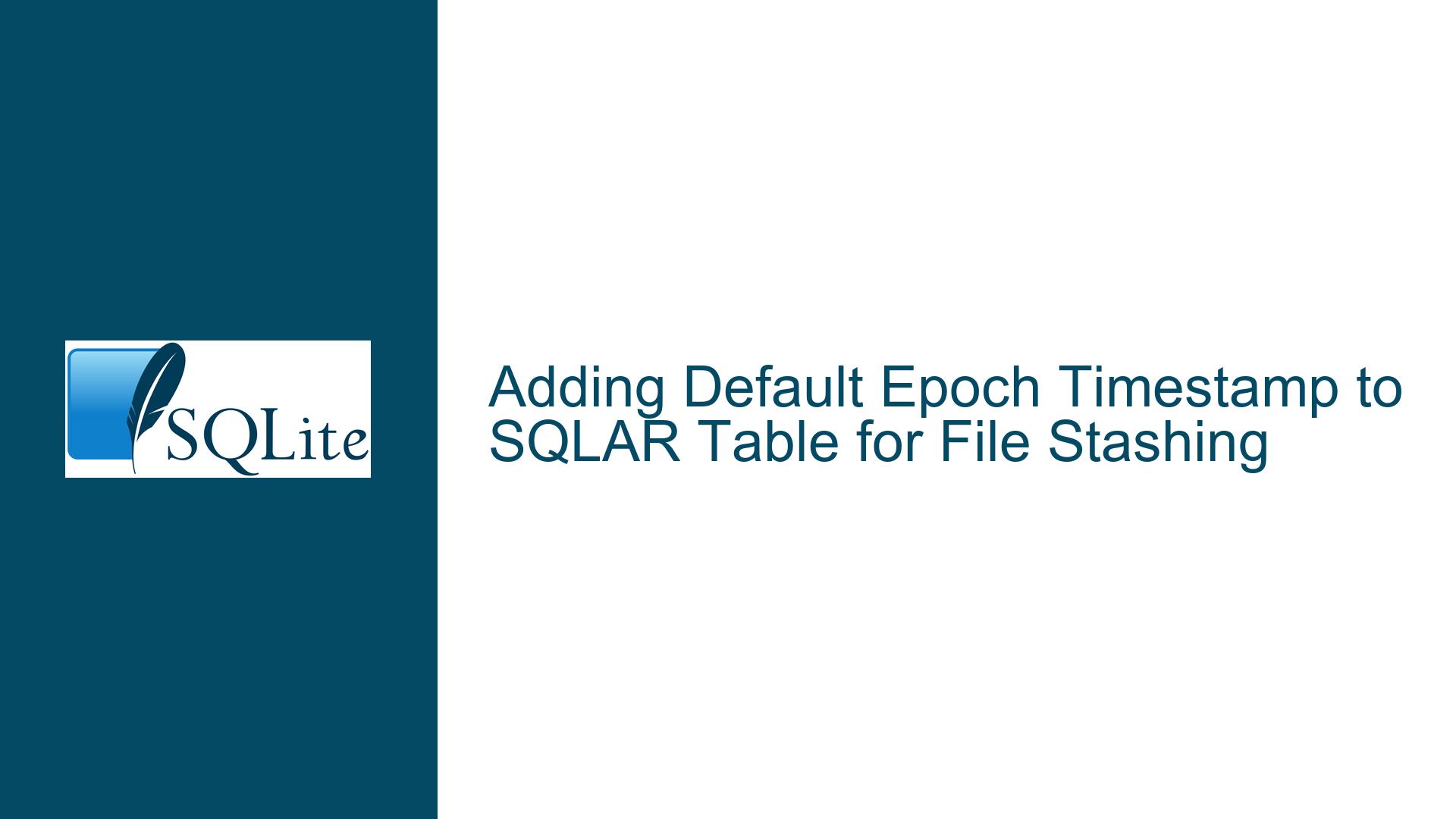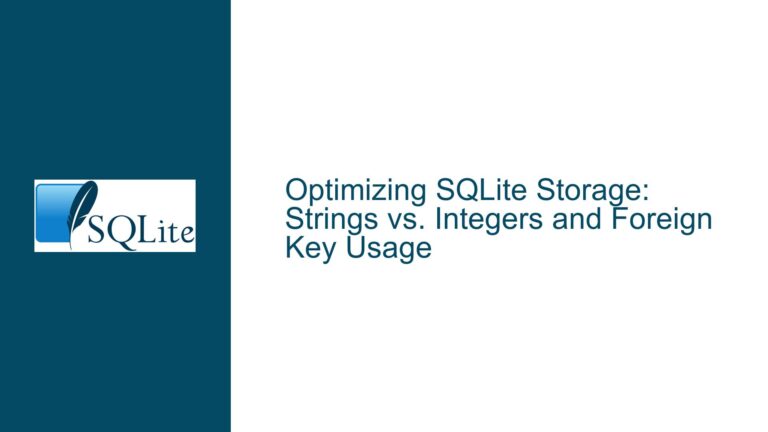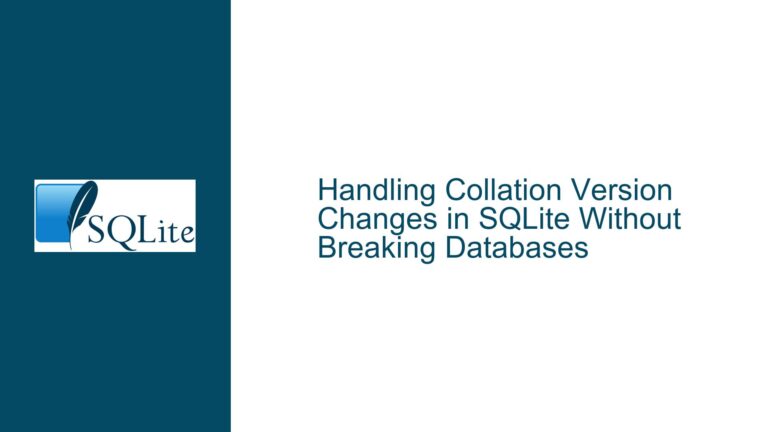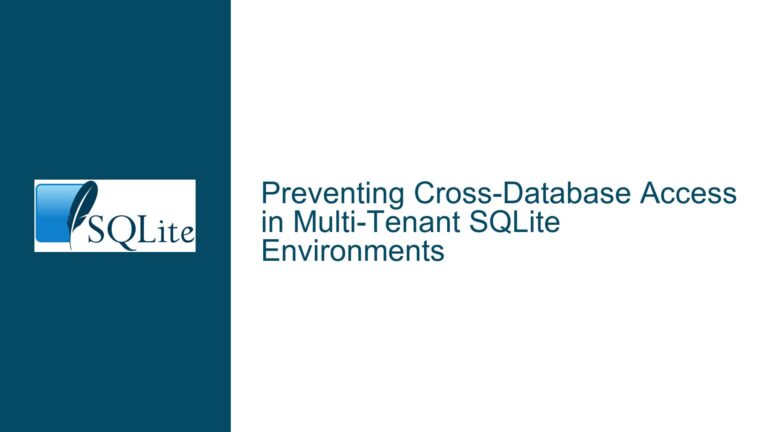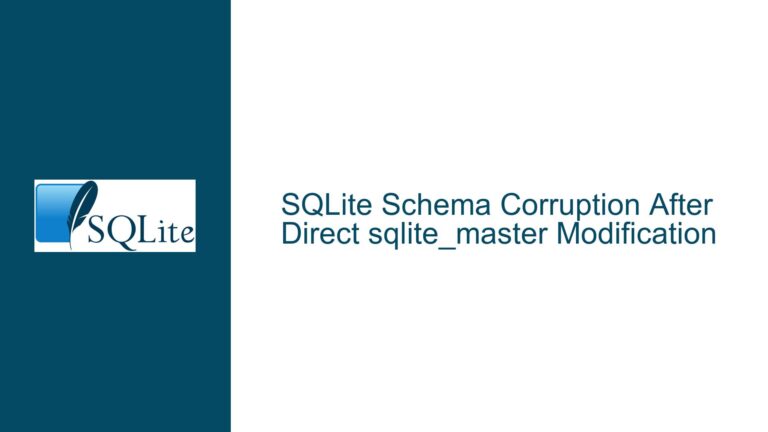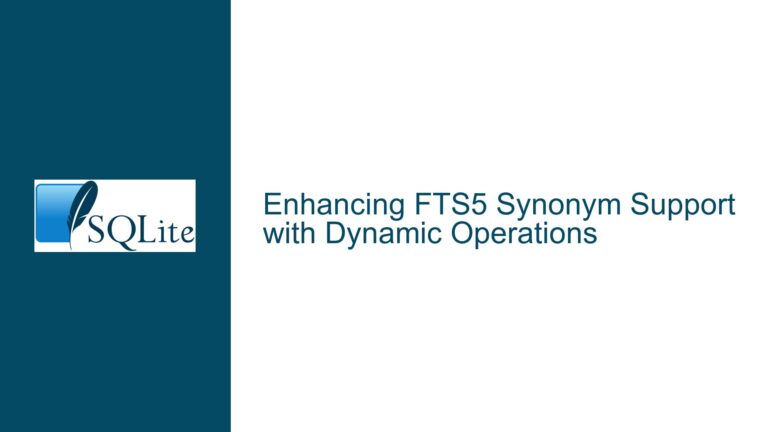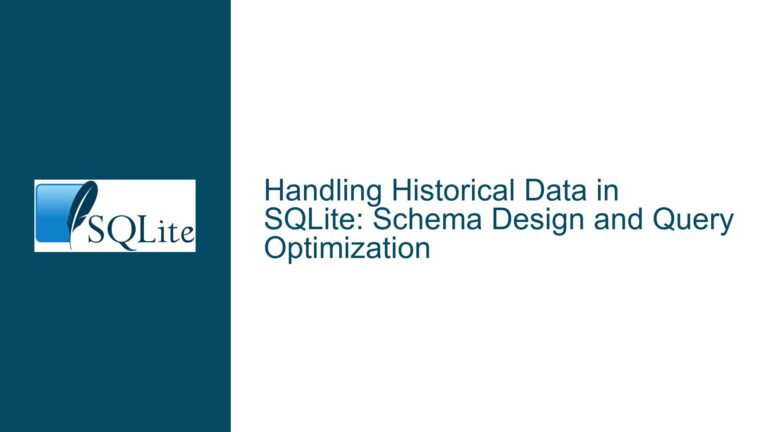Adding Default Epoch Timestamp to SQLAR Table for File Stashing
Issue Overview: Default Epoch Timestamp in SQLAR Table for File Stashing
The core issue revolves around the SQLAR table’s default definition, specifically the mtime column, which currently lacks a default value representing the current time when a file is stashed into the database. The SQLAR table is designed to store files in a SQLite database, mimicking a file system. The table includes columns such as name (file name), mode (file permissions), mtime (modification time), sz (file size), and data (file content). The mtime column is intended to store the modification time of the file, but by default, it is set to the start of the Unix epoch (January 1, 1970) when no value is explicitly provided.
The problem arises when users insert files into the SQLAR table without specifying the mtime value. The extracted files then carry the default epoch timestamp, which is not reflective of the actual time the file was stashed. This behavior is particularly inconvenient for users who rely on the modification time for tracking file changes or for other operational purposes. The user in the discussion proposes modifying the default table definition to include a default value for the mtime column, specifically using the current epoch timestamp generated by strftime('%s', 'now').
The current workaround involves manually defining the SQLAR table with the desired default value for mtime. However, this approach requires users to deviate from the standard table definition provided by SQLite, which can lead to inconsistencies, especially when using SQLite’s built-in commands like .archive --create. The user’s request is to have this default value included in the standard SQLAR table definition, ensuring that all users benefit from the automatic timestamping without needing to manually alter the table schema.
Possible Causes: Why the Default Epoch Timestamp Persists
The persistence of the default epoch timestamp in the SQLAR table can be attributed to several factors, including historical design decisions, backward compatibility concerns, and the specific use cases for which the SQLAR table was originally intended.
Firstly, the SQLAR table was designed to mimic a file system within a SQLite database. In traditional file systems, the modification time (mtime) is a critical metadata attribute that reflects the last time a file was modified. However, when files are stashed into the SQLAR table, the mtime value is not automatically populated with the current timestamp. This design choice may have been made to keep the table definition simple and to avoid imposing additional overhead on users who may not require accurate timestamps.
Secondly, backward compatibility is a significant consideration. The SQLAR table has been part of SQLite for a considerable time, and changing its default definition could potentially break existing applications that rely on the current behavior. For instance, some applications might expect the mtime column to be null or set to the epoch start time by default. Introducing a default value for mtime could lead to unexpected behavior in such applications, especially if they do not handle timestamp values correctly.
Thirdly, the SQLAR table is often used in scenarios where the modification time is either not critical or can be manually set by the user. For example, in archival or backup scenarios, the exact modification time might be less important than the file content itself. In such cases, the default epoch timestamp might be considered acceptable, and users can manually set the mtime value if needed.
However, as the discussion highlights, there are use cases where accurate timestamps are essential. For instance, when stashing SQL commands or text files directly into the database, users may want the extracted files to reflect the actual time they were stashed. In such scenarios, the default epoch timestamp is not only inconvenient but also misleading, as it does not provide any useful information about when the file was added to the database.
Troubleshooting Steps, Solutions & Fixes: Implementing Default Timestamps in SQLAR Table
To address the issue of the default epoch timestamp in the SQLAR table, several approaches can be considered, ranging from modifying the table definition to using triggers or custom functions. Each approach has its advantages and trade-offs, and the choice of solution depends on the specific requirements and constraints of the use case.
Modifying the SQLAR Table Definition
The most straightforward solution is to modify the default definition of the SQLAR table to include a default value for the mtime column. This can be achieved by altering the CREATE TABLE statement to include a default expression that generates the current epoch timestamp. The proposed modification is as follows:
CREATE TABLE "sqlar" (
"name" TEXT,
"mode" INT,
"mtime" INT DEFAULT (strftime('%s', 'now')),
"sz" INT,
"data" BLOB,
PRIMARY KEY("name")
);
In this modified definition, the mtime column is assigned a default value using the strftime('%s', 'now') function, which returns the current time as the number of seconds since the Unix epoch. This ensures that whenever a new row is inserted into the SQLAR table without an explicit mtime value, the current timestamp is automatically assigned.
Advantages:
- Simplicity: The modification is straightforward and does not require additional logic or triggers.
- Consistency: All new rows in the SQLAR table will have an accurate
mtimevalue by default, ensuring consistency across the database. - Ease of Use: Users do not need to manually set the
mtimevalue or modify their existing code to include timestamps.
Disadvantages:
- Backward Compatibility: Existing applications that rely on the default epoch timestamp might break or behave unexpectedly.
- Schema Changes: Modifying the default table definition requires updating the SQLite source code or documentation, which might not be feasible for all users.
Using Triggers to Set the mtime Value
An alternative approach is to use triggers to automatically set the mtime value whenever a new row is inserted into the SQLAR table. This approach allows users to maintain the original table definition while still achieving the desired behavior. The trigger can be defined as follows:
CREATE TRIGGER set_mtime_default
AFTER INSERT ON sqlar
FOR EACH ROW
WHEN NEW.mtime IS NULL
BEGIN
UPDATE sqlar SET mtime = strftime('%s', 'now') WHERE rowid = NEW.rowid;
END;
In this trigger definition, the AFTER INSERT event is used to update the mtime column with the current timestamp whenever a new row is inserted and the mtime value is not explicitly provided.
Advantages:
- Backward Compatibility: The original table definition remains unchanged, ensuring compatibility with existing applications.
- Flexibility: Users can choose to apply the trigger only to specific tables or under certain conditions.
- No Schema Changes: The solution does not require modifying the SQLite source code or documentation.
Disadvantages:
- Complexity: Triggers introduce additional complexity to the database schema, which might be difficult for some users to manage.
- Performance Overhead: Triggers can introduce a slight performance overhead, especially in high-throughput scenarios where many rows are inserted simultaneously.
- Maintenance: Triggers need to be managed and maintained, which can be cumbersome in large or complex databases.
Custom Functions for Timestamp Generation
Another approach is to create a custom SQLite function that generates the current epoch timestamp and use it as the default value for the mtime column. This approach provides greater flexibility and can be extended to include additional logic if needed. The custom function can be defined as follows:
#include <sqlite3.h>
#include <time.h>
void current_timestamp(sqlite3_context *context, int argc, sqlite3_value **argv) {
time_t now = time(NULL);
sqlite3_result_int64(context, (sqlite3_int64)now);
}
int main() {
sqlite3 *db;
sqlite3_open(":memory:", &db);
sqlite3_create_function(db, "current_timestamp", 0, SQLITE_UTF8, NULL, current_timestamp, NULL, NULL);
// Use the custom function in the table definition
sqlite3_exec(db, "CREATE TABLE sqlar (name TEXT, mode INT, mtime INT DEFAULT current_timestamp(), sz INT, data BLOB, PRIMARY KEY(name))", NULL, NULL, NULL);
sqlite3_close(db);
return 0;
}
In this example, a custom function current_timestamp is created using the SQLite C API. The function returns the current time as the number of seconds since the Unix epoch. The function is then used as the default value for the mtime column in the SQLAR table definition.
Advantages:
- Flexibility: Custom functions can be tailored to specific requirements and extended with additional logic if needed.
- Reusability: The custom function can be reused across multiple tables or databases.
- No Schema Changes: The solution does not require modifying the SQLite source code or documentation.
Disadvantages:
- Complexity: Creating and managing custom functions requires programming knowledge and familiarity with the SQLite C API.
- Performance Overhead: Custom functions can introduce a slight performance overhead, especially if they involve complex logic.
- Maintenance: Custom functions need to be managed and maintained, which can be cumbersome in large or complex databases.
Best Practices and Recommendations
When deciding on the best approach to implement default timestamps in the SQLAR table, it is essential to consider the specific requirements and constraints of the use case. Here are some best practices and recommendations to guide the decision-making process:
Evaluate Backward Compatibility: If backward compatibility is a concern, consider using triggers or custom functions instead of modifying the table definition. This ensures that existing applications continue to function as expected.
Assess Performance Impact: Evaluate the performance impact of each approach, especially in high-throughput scenarios. Triggers and custom functions can introduce a slight performance overhead, which might be acceptable in some cases but not in others.
Consider Maintenance Overhead: Choose an approach that aligns with the available resources and expertise. Triggers and custom functions require ongoing maintenance, which might not be feasible for all users.
Document Changes: If modifying the table definition, ensure that the changes are well-documented and communicated to all stakeholders. This helps prevent confusion and ensures that users are aware of the new behavior.
Test Thoroughly: Before implementing any changes, thoroughly test the solution in a controlled environment to ensure that it behaves as expected and does not introduce any unintended side effects.
By carefully considering these factors and selecting the most appropriate approach, users can effectively address the issue of the default epoch timestamp in the SQLAR table and ensure that their database operations are both efficient and accurate.
